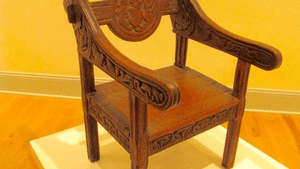Stay in the Loop
BSR publishes on a weekly schedule, with an email newsletter every Wednesday and Thursday morning. There’s no paywall, and subscribing is always free.
Hiding in plain sight
The American Swedish Historical Museum's Flowers and Monsters

Dread the clamor and crowds that come with big-ticket art events? Seek out Flowers and Monsters: Hand-Carved Furniture by Karl von Rydingsvärd, at the American Swedish Historical Museum (ASHM). It’s an understated display of an almost-forgotten woodcarver, in what may be Philadelphia’s most obscure museum.
This well-concealed place is the perfect setting for the artistry of von Rydingsvärd (1863-1941). Flowers and Monsters, painstakingly curated by ASHM’s Carrie Hogan, sheds light on the Swedish immigrant who, a century ago, advanced the Arts and Crafts style and popularized his craft in his teaching and writing.
Utility and beauty
Von Rydingsvärd was born in Sweden’s rural Dalsland province, where tilling the soil often turned up ancient Norse artifacts. He was one of nine children, all of whom were expected to help on the farm, making whatever tools and household items were needed.
The mythology that surrounded him, and the expectation that craft items be useful, connected in von Rydingsvärd’s art. He made beautiful, purposeful things, decorating chairs and picture frames with twining vines, coronets, heroic visages, and legendary creatures. The exhibition includes a dining room set, drop-leaf desk, magazine rack, and fireplace bellows, all solid oak, used daily for more than a century, and intricately carved with the creatures and symbols that infused von Rydingsvärd’s imagination.
This is what sets von Rydingsvärd’s version of the Arts and Crafts (also known as Mission) design style apart from that of the movement’s star, Gustav Stickley. Where Stickley’s furniture is spindly and streamlined, von Rydingsvärd’s pieces are solid and sculptural, thick with curling snakes, sword-wielding Vikings, and dragons.
An apostle for woodworking
“Wood-working is a most pleasant practice because the brain and imagination are balanced by effort of a purely manual nature,” von Rydingsvärd wrote. He believed the craft should be available to anyone. Proposing woodworking as therapy for nervous and other psychological disorders, he advised New York Hospital, and trained teachers to instruct returning World War I veterans.
Von Rydingsvärd became an apostle of the craft. He founded the Arts and Crafts School in Boston, taught summers at his home in Brunswick, Maine, and wrote about necessary skills and methods of cultivating them as in a 1907 article, “Practical Points in Woodcarving,” in which he advised, “those who receive instruction accomplish much more with constant practice at home and lessons at intervals than those who work wholly under a teacher’s guidance.”
He taught carving to anyone who wanted to learn, leading classes at Columbia Teacher’s College, the Rhode Island School of Design, and founding schools for female carvers. At the time, women were expected to pursue gentler crafts such as sewing, but von Rydingsvärd didn’t discriminate: He had them hacking dragons out of unvarnished oak. The scaly beasts, he felt, were particularly suited to novices’ rough strokes.
Celebrating Swedish contributions to America
Von Rydingsvärd represents just a sliver of the Swedish history, culture, and accomplishment to be discovered at ASHM, which was founded in 1926, in conjunction with the American Sesquicentennial. The museum formally opened in 1938, three centuries after Swedes and Finns established New Sweden Colony here.
Established in 1638, New Sweden Colony was the first permanent European settlement in the Delaware Valley and one of the earliest colonial ventures in America. The settlement bracketed the Delaware River, taking in parts of what are now Pennsylvania, New Jersey, and Delaware. Beautiful, purposeful, detailed, and unexpected, ASHM is the ideal place in which to discover von Rydingsvärd’s work.
What, When, Where
Flowers and Monsters: Hand-Carved Furniture by Karl von Rydingsvärd. Through Dec. 31, 2016 at the American Swedish Historical Museum, 1900 Pattison Ave., Philadelphia. (215) 7389-1776 or americanswedish.org.
Sign up for our newsletter
All of the week's new articles, all in one place. Sign up for the free weekly BSR newsletters, and don't miss a conversation.
